At the heart of any test system, the motherboard is the highway that links communication roads between the CPU, custom peripheral components, and memory. Motherboards contain complex subsystems and house all the electrical connections these subsystems use to transmit data.
The increasing complexity of computing coupled with the pressure to develop custom solutions makes the selection of the motherboard design more critical than ever. There are three main types of motherboards. Here is how you can select the best one for your custom test system:
ATX Server
The most common motherboard is ATX due to its compact footprint, durability, and reliability. ATX server and Workstation motherboards offer both high-performance and low-cost deployment platforms for applications such as manufacturing test, military, aerospace, automotive and industrial test. The original ATX server was 12 x 9.6” and contained seven expansion slots. Engineers have developed several subsequent ATX sizes for use in various applications and PC sizes, which determine the type of ATX to select. In decreasing order of size, three standard sizes are ATX, micro ATX and mini ATX. The primary difference between the sizes of ATX motherboards is the number of expansion slots, RAM slots and USB ports.
ATX is capable of handling fast and intense computational processing allowing for a wider variety of newer supported technologies. I/O chipsets and slots can interface with legacy external components as needed. This motherboard type delivers real-time control functionality with a cost-efficient configuration and allows easy system control.
The ATX is ideal for large-volume personal and professional consumer use because of its compact size and efficient cost. They are more cost-efficient than single-board or custom solutions, so it makes sense that the most economical option would enjoy the substantial economies of scale. In addition, leveraging the latest long-life (5-7 years) commercial technology further improves the economics of ATX.
ATX server and workstation motherboards have a form factor to fit in short 4U rackmount chassis while allowing up to 7 PCI or PCIe slots. Select server and workstation boards will have dual LAN and dual video onboard, with enough USB ports for most applications.
For more compact ATX server solutions, 1U, 2U, or Micro ATX 3U support chassis offer simple, low-cost, high-performance options with external control for test equipment. This capability makes a smooth connection for the PXI chassis.
Single Board Computer
For applications that require more expansion, single-board computers (SBC) offer a suitable option. A single-board computer configures one board into the backplane. This system architecture provides the interface connections for the board. SBC motherboards have up to 14 slots and reduce the overall system cost by increasing the density of integrated circuits.
Automated test systems and applications that require a high level of control, such as space and ocean exploration, employ SBC over ATX. This choice is due to SBC’s high level of control and increased expansion capability. Processing power determines the appropriate size of an SBC. They are typically smaller and lighter weight than their ATX counterparts due to higher levels of integration.
Custom
Custom motherboard design may be the best choice for specialized applications, such as military projects and extreme temperature environments. These industrial motherboards are built for longevity and are backed by a 7-10 year production guarantee. Their longevity virtually eliminates the costs of device incompatibility, tooling changes, re-certifications, and rebidding.
Custom motherboards are designed to exceed the most complex computing requirements through the harshest conditions. They are built to operate at peak performance under extreme surroundings on sea, land, air, or space across mission-critical applications. These boards are stress-tested and certified to military and industrial standards such as the MIL-STD-810, MIL-STD-461, MIL-S-901, CE, UL, and FCC.
Choosing a partner that has the design tools and engineers leads to an appropriately engineered solution that meets your unique specifications.
Takeaway
General Technics can create an application tailored to your specific application. We provide high accuracy, high-speed, customizable test solutions, and offer rackmount controllers that have been tested for compatibility and performance.
We have nearly 40 years of expertise and offer expert customer service and agility in customization. These benefits allow you to manage the cost of your system while leveraging our expertise to provide the best solution for your application.

